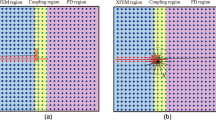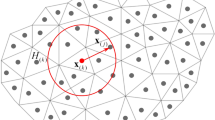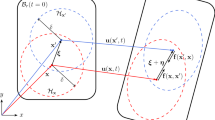Abstract
This study presents an ordinary state-based peridynamic (OSB PD) analysis within the finite-element framework while considering implicit/explicit solvers. The present PD formulation permits non-uniform discretization with a variable horizon and eliminates the use of external surface and volume correction factors. An implicit solver is employed until immediately before damage emerges, and then an adaptive time-stepping explicit solver for crack initiation and propagation. The major advantage of the present approach is the reduction in computational time. The PD interactions lead to a sparsely populated global stiffness matrix. The BiConjugate Gradient Stabilized (BICGSTAB) method is employed to determine the solution of the system equations. Damage onset and its evolution is investigated using the critical stretch criterion. The efficacy of the present approach is established by considering two different geometric configurations and loading/boundary conditions. The PD predictions for the crack patterns compare well with those of the analytical results and experimental observations.













Similar content being viewed by others
References
Agwai A, Guven I, Madenci E (2011) Predicting crack propagation with peridynamics: a comparative study. Int J Fract 171:65. https://doi.org/10.1007/s10704-011-9628-4
Gui YJ, Yu Y, Hu YL, Zhang YT, Lei LW (2021) A peridynamic cohesive zone model for composite laminates. J Peridynamics Nonlocal Model. https://doi.org/10.1007/s42102-021-00052-3
Dorduncu M (2021) Peridynamic modeling of delaminations in laminated composite beams using refined zigzag theory. Theor Appl Fract Mech 112:102832. https://doi.org/10.1016/j.tafmec.2020.102832
Amiri F, Anitescu C, Arroyo M, Bordas SPA, Rabczuk T (2014) XLME interpolants, a seamless bridge between XFEM and enriched meshless methods. Comput Mech 53:45–57. https://doi.org/10.1007/s00466-013-0891-2
Dorduncu M, Barut A, Madenci E, Phan N (2017) Peridynamic augmented XFEM. In: 58th AIAA/ASCE/AHSASC Struct. Struct. Dyn. Mater. Conf., American Institute of Aeronautics and Astronautics. https://doi.org/10.2514/6.2017-0656
Silling SA (2000) Reformulation of elasticity theory for discontinuities and long-range forces. J Mech Phys Solids 48:175–209. https://doi.org/10.1016/S0022-5096(99)00029-0
Silling SA, Epton M, Weckner O, Xu J, Askari E (2007) Peridynamic states and constitutive modeling. J Elast 88:151–184. https://doi.org/10.1007/s10659-007-9125-1
Madenci E, Dorduncu M, Barut A, Phan N (2018) A state-based peridynamic analysis in a finite element framework. Eng Fract Mech 195:104–128. https://doi.org/10.1016/j.engfracmech.2018.03.033
Madenci E, Dorduncu M, Barut A, Phan N (2018) Weak form of peridynamics for nonlocal essential and natural boundary conditions. Comput Methods Appl Mech Eng 337:598–631. https://doi.org/10.1016/j.cma.2018.03.038
Javili A, Morasata R, Oterkus E, Oterkus S (2019) Peridynamics review. Math Mech Solids 24:3714–3739. https://doi.org/10.1177/1081286518803411
Isiet M, Mišković I, Mišković S (2021) Review of peridynamic modelling of material failure and damage due to impact. Int J Impact Eng 147:103740. https://doi.org/10.1016/j.ijimpeng.2020.103740
Madenci E, Oterkus E (2014) Peridynamic theory and its applications. Springer-Verlag, New York. https://doi.org/10.1007/978-1-4614-8465-3
Madenci E, Barut A, Dorduncu M (2019) Peridynamic differential operator for numerical analysis. Springer International Publishing, Cham. https://doi.org/10.1007/978-3-030-02647-9
Dorduncu M, Olmus I, Rabczuk T (2022) A peridynamic approach for modeling of two dimensional functionally graded plates. Compos Struct 279:114743. https://doi.org/10.1016/j.compstruct.2021.114743
Silling S, Littlewood D, Seleson P (2015) Variable horizon in a peridynamic medium. J Mech Mater Struct 10:591–612. https://doi.org/10.2140/jomms.2015.10.591
Bobaru F, Ha YD (2011) Adaptive refinement and multiscale modeling in 2D peridynamics. Int J Multiscale Comput Eng. https://doi.org/10.1615/IntJMultCompEng.2011002793
Dipasquale D, Sarego G, Zaccariotto M, Galvanetto U (2016) Dependence of crack paths on the orientation of regular 2D peridynamic grids. Eng Fract Mech 160:248–263. https://doi.org/10.1016/j.engfracmech.2016.03.022
Ren H, Zhuang X, Rabczuk T (2017) Dual-horizon peridynamics: a stable solution to varying horizons. Comput Methods Appl Mech Eng 318:762–782. https://doi.org/10.1016/j.cma.2016.12.031
Zhang Y, Yang X, Wang X, Zhuang X (2021) A micropolar peridynamic model with non-uniform horizon for static damage of solids considering different nonlocal enhancements. Theor Appl Fract Mech 113:102930. https://doi.org/10.1016/j.tafmec.2021.102930
Hu Y, Chen H, Spencer BW, Madenci E (2018) Thermomechanical peridynamic analysis with irregular non-uniform domain discretization. Eng Fract Mech 197:92–113. https://doi.org/10.1016/j.engfracmech.2018.02.006
Madenci E, Dorduncu M, Barut A, Futch M (2017) Numerical solution of linear and nonlinear partial differential equations using the peridynamic differential operator. Numer Methods Partial Differ Equ 33:1726–1753. https://doi.org/10.1002/num.22167
Dorduncu M, Kaya K, Ergin OF (2020) Peridynamic analysis of laminated composite plates based on first-order shear deformation theory. Int J Appl Mech 12(03):2050031. https://doi.org/10.1142/S1758825120500313
Madenci E, Dorduncu M, Gu X (2019) Peridynamic least squares minimization. Comput Methods Appl Mech Eng 348:846–874. https://doi.org/10.1016/j.cma.2019.01.032
Dorduncu M (2020) Peridynamic modeling of adhesively bonded beams with modulus graded adhesives using refined zigzag theory. Int J Mech Sci 185:105866. https://doi.org/10.1016/j.ijmecsci.2020.105866
Kilic B, Madenci E (2010) An adaptive dynamic relaxation method for quasi-static simulations using the peridynamic theory. Theor Appl Fract Mech 53:194–204. https://doi.org/10.1016/j.tafmec.2010.08.001
Macek RW, Silling SA (2007) Peridynamics via finite element analysis. Finite Elem Anal Des 43:1169–1178. https://doi.org/10.1016/j.finel.2007.08.012
Lall P, Shantaram S, Panchagade D (2010) Peridynamic-models using finite elements for shock and vibration reliability of leadfree electronics. In: 12th IEEE Intersociety Conference on Thermal and Thermomechanical Phenomena in Electronic Systems. https://doi.org/10.1109/ITHERM.2010.5501274
Beckmann R, Mella R, Wenman MR (2013) Mesh and timestep sensitivity of fracture from thermal strains using peridynamics implemented in Abaqus. Comput Methods Appl Mech Eng 263:71–80. https://doi.org/10.1016/j.cma.2013.05.001
Dorduncu M, Barut A, Madenci E (2015) Ordinary-State Based Peridynamic Truss Element. In: 56th AIAA/ASCE/AHS/ASC Struct. Struct. Dyn. Mater. Conf., American Institute of Aeronautics and Astronautics. https://doi.org/10.2514/6.2015-0465
Dorduncu M, Barut A, Madenci E (2016) Peridynamic Truss Element for Viscoelastic Deformation. In: 57th AIAA/ASCE/AHS/ASC Struct. Struct. Dyn. Mater. Conf., American Institute of Aeronautics and Astronautics. https://doi.org/10.2514/6.2016-1721
Diyaroglu C, Oterkus S, Oterkus E, Madenci E (2017) Peridynamic modeling of diffusion by using finite-element analysis. IEEE Trans Compon Packaging Manuf Technol 7(11):1823–1831. https://doi.org/10.1109/TCPMT.2017.2737522
Fang G, Liu S, Fu M, Wang B, Wu Z, Liang J (2019) A method to couple state-based peridynamics and finite element method for crack propagation problem. Mech Res Commun 95:89–95. https://doi.org/10.1016/j.mechrescom.2019.01.005
Zhang Y, Madenci E (2021) A coupled peridynamic and finite element approach in ANSYS framework for fatigue life prediction based on the kinetic theory of fracture. J Peridynamics Nonlocal Model. https://doi.org/10.1007/s42102-021-00055-0
Zhang Y, Madenci E, Zhang Q (2022) ANSYS implementation of a coupled 3D peridynamic and finite element analysis for crack propagation under quasi-static loading. Eng Fract Mech 260:108179. https://doi.org/10.1016/j.engfracmech.2021.108179
Madenci E, Barut A, Dorduncu M, Phan N (2018) Coupling of peridynamics with finite elements without an overlap zone. In: 2018 AIAA/ASCE/AHS/ASC Struct. Struct. Dyn. Mater. Conf., American Institute of Aeronautics and Astronautics. https://doi.org/10.2514/6.2018-1462
Yang Z, Oterkus E, Nguyen CT, Oterkus S (2019) Implementation of peridynamic beam and plate formulations in finite element framework. Continuum Mech Thermodyn 31:301–315. https://doi.org/10.1007/s00161-018-0684-0
van der Vorst HA (1992) Bi-CGSTAB: a fast and smoothly converging variant of Bi-CG for the solution of nonsymmetric linear systems. SIAM J Sci Stat Comput 13:631–644. https://doi.org/10.1137/0913035
Zohdi TI (2013) Numerical simulation of the impact and deposition of charged particulate droplets. J Comput Phys 233:509–526. https://doi.org/10.1016/j.jcp.2012.09.012
Silling SA, Askari E (2005) A meshfree method based on the peridynamic model of solid mechanics. Comput Struct 83:1526–1535. https://doi.org/10.1016/j.compstruc.2004.11.026
Anderson TL (2017) Fracture mechanics: fundamentals and applications, 3rd edn. CRC Press, Boca Raton. https://doi.org/10.1201/9781315370293
Winkler B, Hofstetter G, Niederwanger G (2001) Experimental verification of a constitutive model for concrete cracking. Proc Inst Mech Eng Part J Mater Des Appl 215:75–86. https://doi.org/10.1177/146442070121500202
Meschke G, Dumstorff P (2007) Energy-based modeling of cohesive and cohesionless cracks via X-FEM. Comput Methods Appl Mech Eng 196:2338–2357. https://doi.org/10.1016/j.cma.2006.11.016
Wang Y, Han F, Lubineau G (2021) Strength-induced peridynamic modeling and simulation of fractures in brittle materials. Comput Methods Appl Mech Eng 374:113558. https://doi.org/10.1016/j.cma.2020.113558
Mandal TK, Nguyen VP, Wu J-Y (2022) On a new high order phase field model for brittle and cohesive fracture: numerical efficiency, length scale convergence and crack kinking. Comput Mater Sci 203:111079. https://doi.org/10.1016/j.commatsci.2021.111079
Acknowledgements
This study was performed as part of the ongoing research at the MURI Center for Material Failure Prediction through Peridynamics at the University of Arizona (AFOSR Grant No. FA9550-14-1-0073) and it was supported by Erciyes University Scientific Research Projects Coordination Unit (Grant No. 11070).
Funding
This work was funded by Erciyes Üniversitesi (Grant no. 11070); Air Force Research Laboratory (Grant no. FA9550-14-1-0073).
Author information
Authors and Affiliations
Corresponding author
Additional information
Publisher's Note
Springer Nature remains neutral with regard to jurisdictional claims in published maps and institutional affiliations.
Rights and permissions
About this article
Cite this article
Dorduncu, M., Madenci, E. Finite element implementation of ordinary state-based peridynamics with variable horizon. Engineering with Computers 39, 641–654 (2023). https://doi.org/10.1007/s00366-022-01641-6
Received:
Accepted:
Published:
Issue Date:
DOI: https://doi.org/10.1007/s00366-022-01641-6




